Ordinatio Sacerdotalis, an apostolic letter published by Pope St. John Paul II in 1994, was the climax of religious patriarchalism and arguably the climax of the patriarchal culture that has prevailed since the inception of human history. This ancient culture of competition and efficiency to attain domination, as opposed to collaboration and resilience to pursue social/ecological justice in harmony with the human habitat, has led human civilization to acts of violent ecocide and has induced the social/ecological crisis now unfolding worldwide. History confirms that religious patriarchy and the patriarchal culture are inextricably connected and reinforce each other. This page offers a meditation on the rise and fall of Christendom. The higher the ascent, the harder the fall. Going forward, can we mitigate the pain during the inevitable descent?
As we enter the third decade of the third millennium of the Christian era, it is time to test everything, keep what is good, question what is not so good, and discard what is bad. With regard to social and ecological issues, do we want to go back to "business as usual"? The COVID-19 pandemic is an incentive for reconsidering, isn't it? Do we want to go back to the patriarchal mantra of "more is better, under me, no matter how" that has prevailed since the inception of human history?
Reconsidering the mantra of human expansionism as a "divine law" that mandates human domination of nature (and conveniently ignores another "divine law" that requires us to take good care of nature) is practically impossible unless the deep conflation of cultural and religious traditions is taken into account. This article attempts to broadly analyze the dynamics of such conflation during the rise and fall of patriarchal Christendom, a process that started in the 1st century CE and peaked toward the end of the 20th century.
Lynne White's seminal article, The Historical Roots of the Ecologic Crisis (1967), is a good place to start. The historical confluence of Greek anthropocentrism and Roman imperialism vitiated the emergence of Christendom after the "conversion" of Constantine. It should be clear that such theocratic conception of governance is not intrinsic to the Christian faith; in fact, Jesus of Nazareth was crucified for challenging the mutual accommodation of religious authority and imperial authority in his native Israel. Nevertheless, Christendom was built on the ashes of the Roman empire, and the subsequent history of human expansionism under a "Christian" banner is well known: the crusades, the Holy Roman empire, the "holy" inquisition, feudal serfdom, religious wars, the brutal "evangelization" of America and, with the discovery of fossil fuels, the industrial revolution, two world wars, and the globalization of poverty for the benefit of national and international oligarchies.
Indeed, the domineering propensities of Christendom were inherited from practices of domination by brute force that were already prevalent during the agricultural revolution that happened at the dawn of human history. It had started in prehistorical times with the corruption of natural human relations -- between humans, and between humans and the human habitat -- but the growth of human population and surplus food eventually led to the Babylonian empire, the Egyptian empire, the Roman empire, and many other empires in other regions of the planet, all of them growing and expanding by brute force. Patriarchy has deep roots in human history and it is now becoming ecocidal, threatening the very survival of the human species. Sin has a long tail!
By way of giving bad example, religious institutions are complicit. In 1054, an ecclesiastical power struggle between the Pope of Rome, who was then the patriarch of the West, and the patriarch of the East in Constantinople, precipitated mutual excommunications and the separation of the Catholic and Orthodox churches. Fast forward 842 years, and the same kind of power struggle in repeated between Rome and Canterbury. In his apostolic letter Apostolicae Curae, published in 1896, Pope Leo XIII declared Anglican orders to be "absolutely null and void." In their response entitled Saepius Officio, published the very following year, the Anglican archbishops of Canterbury and York show, convincingly, that not even the papal apostolic succession credentials meet the requirements proposed in Apostolicae Curae. To this date, there has been no Vatican refutation of Saepius Officio.
And so we keep going, with clerics debating their clerical credentials ad nauseam, while the era of Christendom and caesaropapism mercifully passes away in utter disrepute. The same pattern of clerical misbehavior happens in all patriarchal religious institutions. Indeed, it happened to Jesus in dealing with the pharisaical clerical establishment of his time. Clericalism is bad, but patriarchal clericalism is even worse and utterly incompatible with integral human development and an integral ecology. Humans have difficulty learning from history. Clerical humans, even more so. Patriarchal clerics are hopeless. The ugly repercussions for social/ecological justice are now exploding as a global ecological crisis. COVID-19 is a minor pandemic. Around 9 million people die every year of hunger and hunger-related diseases.
Meanwhile, much ink continues to be spent rationalizing patriarchal aberrations such as canon 1024 of the Catholic Code of Canon Law, which states that "a baptized male alone receives sacred ordination validly." This absurdity is rationalized as official doctrine in section 1577 of the Catechism of the Catholic Church, published in 1992. In 1994, in a perplexing attempt to suppress further discussion of the issue, Pope St. John Paul II published the apostolic letter Ordinatio Sacerdotalis on "reserving priestly ordination to men alone," and the following year the Vatican doubled down by claiming that it was dogmatic. For a detailed analysis of this climax of religious patriarchy, see Religious Patriarchy in the Judeo-Christian Tradition. Saints make mistakes!
Canon 1024, and the supporting doctrinal rationalizations, are legacy of patriarchal gender ideology (i.e., the Aristotelian "women are defective males") and the consequent theology of mutually exclusive gender complementarity (i.e., the patriarchal binary, and men and women being human and mutually complementary but not, ontologically, equally human). Actually, St. John Paul II's Theology of the Body clearly explains that man and woman are fully consubstantial and fully share one and the same human nature; else, they could not possibly enjoy relational complementarity. It is precisely their somatic homogeneity that enables the males and females of the human species to be relationally complementary. There is, of course, man in woman and woman in man, and a renewal of humanity is contingent on a renewal of human relations -- between man and woman, and between humans and the human habitat.
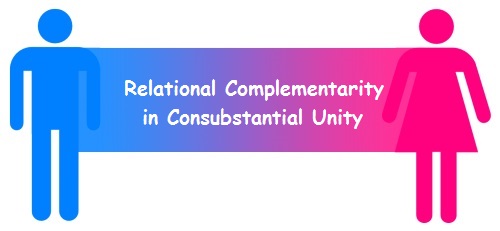
Reference: Man & Woman ~ Relational Complementarity in Consubstantial Unity
The rigidity of canon 1024 betrays its artificiality. It is a mixture of natural human sexuality and patriarchal gender ideology. Humanity is male and female, not male or female. The biological and psychological sciences now confirm that there is a natural gender spectrum, whereas the patriarchal gender binary is unnatural. Human bodies are, normally, male or female; but human persons are, subjectively, masculine and feminine. There is Yin in Yang, and there is Yang in Yin, even though, due to cultural pressures, men often repress their inner Yin and women often repress their inner Yang. This renewed understanding of human sexuality, which is fully consistent with the Theology of the Body, is crucial for integral human development, for an integral ecology, and for both social and ecological justice. Why so? These are some key reasons:
1. Balancing of social/ecological relations ~ The relation between humanity and the human habitat is a mirror of the relation between man and woman. The converse is also true: the relation between man and woman is a mirror of the relation between humanity and the human habitat. Since the inception of human history, all social and ecological relations have been corrupted by an abusive hegemony of male over female. Religious traditions have myths about how gender relations became flawed in prehistorical times, such as the story of "original sin" in the Judeo-Christian tradition. Recent cultural evolution pursuant to correcting this social/ecological disorder must continue and be consciously expedited, but patriarchal religious institutions constitute a grave obstacle. There is no way in the world that the current global predicament can be survived as along as natural, egalitarian relations of unity in mutuality between man and woman are not restored.
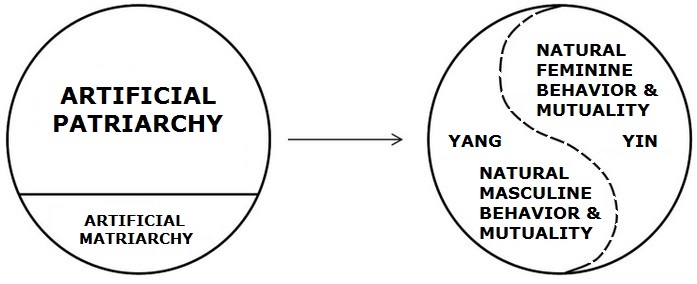
Gender Relations ~ Evolution from Rigid Patriarchy to Egalitarian Mutuality
The dashed line in the Yang-Yin circle denotes integrative overlap instead of a rigid binary
Reference: Making Our World Sustainable ~ Three Paradigm Shifts To Achieve
2. Balancing demographic imbalances via responsible parenthood ~ Since it is a well-known fact that overpopulation is the main driver of all social and ecological impacts, egalitarian relations of unity in mutuality between man and woman are necessary, but not sufficient. Both men and women must procreate in a responsible manner. This means balancing their personal desires with the well-being of both their children and the entire community of creation. When sexual relations lead to more and more babies, whether or not parents can take care of them, and whether or not they add excess burden (footprint) on the planet, continuing demographic growth becomes unethical. Responsible parenthood entails commitment (by both parents!) to take care of the children and to regulate births for the common good. When the planet was inhabited by one million humans, or even one billion humans, patriarchal nuptial covenants were wrong but feasible. Now that we have 7.8 billion, with projections to keep growing to 10 billion or more by the end of the 21st century, the old norms of patriarchy and matriarchy are both wrong and unfeasible.
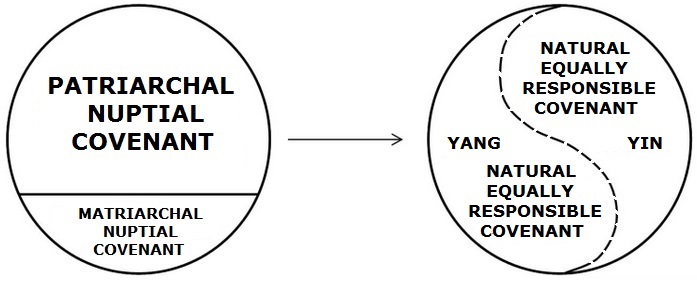
Nuptial Relations ~ Evolution from Rigid Patriarchy to Equal Authority & Responsibility
The dashed line in the Yang-Yin circle denotes integrative overlap instead of a rigid binary
Reference: Making Our World Sustainable ~ Three Paradigm Shifts To Achieve
3. Balancing of resilience and efficiency/productivity ~ Demographic impacts are further exacerbated by an industrial economy empowered by fossil fuels and inflated by financial incentives that generate more and more debt and the need for more and more babies that grow up to become cheap labor. Communism is dead. Capitalism is practically dead. What we have now is a neoliberal, neofeudalist system of globalization (aka the
Anthropocene) that allocates practically all resources to more efficiency and productivity to produce more and more stuff and consume more and more stuff, ad nauseam, and invests practically nothing to maintain social cohesion and infrastructure resilience. The basic principles of solidarity, subsidiarity, and sustainability are sacrificed at the altar of short-term financial benefit for the wealthy and long-term ruin for the poor and the planet. We urgently need an industrial ecology that balances resilience and efficiency, as natural ecosystems do. Evolution toward social justice and a sustainable ecological economy is contingent on a universal renewal of human relations as outlined in 1 and 2 above.
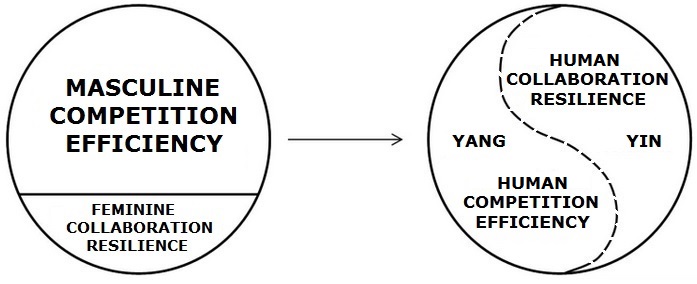
Human Relations ~ Evolution from Rigid Patriarchy to Solidarity & Sustainability
The dashed line in the Yang-Yin circle denotes integrative overlap instead of a rigid binary
Reference: Making Our World Sustainable ~ Three Paradigm Shifts To Achieve
"Everything is connected" (LS 91, 117). "There can be no renewal of our relationship with nature without a renewal of humanity itself" (LS 118). Religious traditions influence culture and are influenced by culture. Religious patriarchy is based on an inadequate anthropology, and therefore makes a renewal of human relations practically impossible. For this reason, it is imperative that religious institutions liberate themselves from the patriarchal mindset of male headship. In the largest and arguably most influential of these institutions -- the Catholic Church, 1.2 billion strong -- this phallocentric mindset is still enshrined in the patriarchal hierarchy that excludes women from apostolic succession. The Virgin Mary is certainly a significant feminine presence in the life of the church, but a more incisive and liturgically visible feminine presence is desperately needed in the church hierarchy, and in the liturgy, to foster the kind of "cultural revolution" (LS 114) that is needed at this time in human history. Such feminine presence can only become reality with the ordination of women to the priesthood and the episcopate. May it happen soon!
The publication of the apostolic letter Ordinatio Sacerdotalis by Pope St. John Paul II in 1994 was the climax of religious patriarchy. Since religious patriarchy and the patriarchal culture are inextricably connected and reinforce each other; and since the historical combination of these cultural forces is the main driver of social/ecological injustice worldwide, we urgently need a renewal of human relations to balance the masculine and feminine polarities of human nature, the Yang and the Yin, competition and collaboration, efficiency and resilience, power and tenderness. Patriarchal liturgies are now becoming an obstacle to integral human development and an integral ecology. To foster a renewal of humanity in harmony with the human habitat, celibate women should be ordained to the priesthood and the episcopate in the Catholic Church.
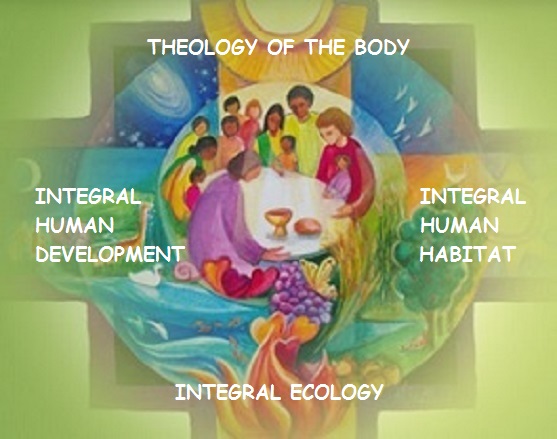
Original art by Mary Southard, CSJ ~ Ministry of the Arts
Reference: Summary Points for Meditation on the Ordination of Women